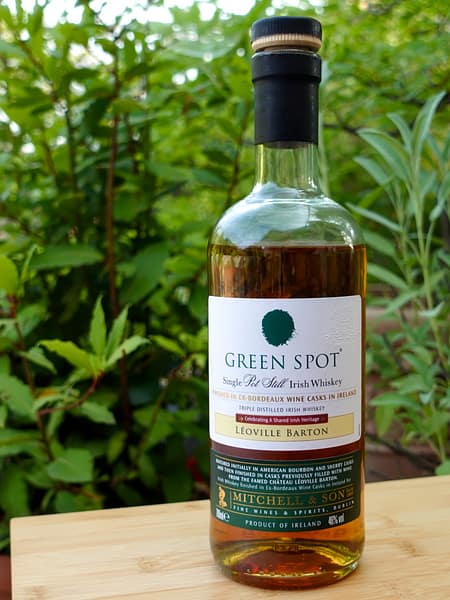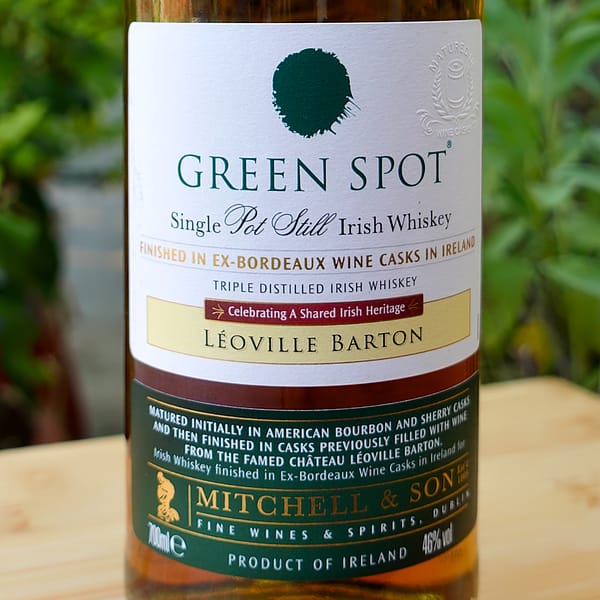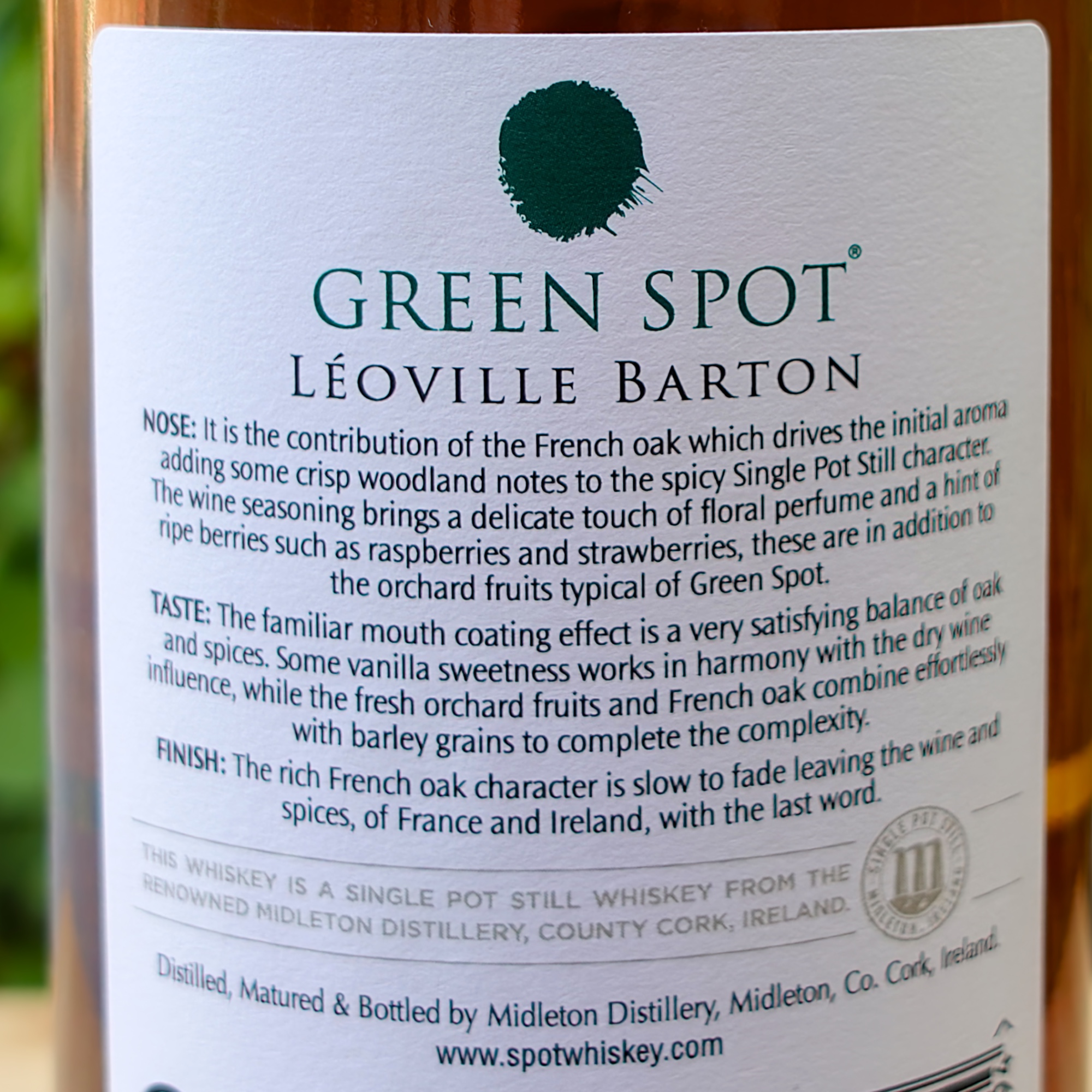Today’s review of the Green Spot Chateau Leoville Barton rounds up my short vacation in the world of Irish whiskey. As with every vacation, it has been fun (especially Dingle I must admit) and it has left a curiosity to explore some more. Tens of new distilleries just have or are on the verge of releasing their first whiskies. It sure seems the Irish whiskey scene could have lots to say in the future.

TL:DR: To quote a famous Jedi master…“Strong the red wine influence in this one is”.
Score: 6.5 between good stuff and very good stuff.
The Spot Whiskeys
Today’s whiskey in review, the Green Spot Chateau Leoville Barton, shares a lot with my first review of this short Irish series, the Redbreast 12. Both are made at the huge Midleton facility. Both were the only remaining examples of Single Pot Still Whisky in the 80s before the slow resurgence of Irish distillation began.
Finally, both were originally Independently Bottled whiskies produced from spirit made at the long-gone Jameson Distillery in Dublin. Green Spot still carries the name of Mitchell & Sons, the wine merchant originally producing the Spot whiskies. Contrary to Redbreast, which was sold to Irish Distillers as a brand, Mitchell & Son retains rights to market, sell, and develop the whiskey, even if production is fully taking place at the Midleton site.
The so-called “Spot Whiskies” were born in the early XIX century when Mitchell & Sons used to age the spirit coming from the Jameson distillery using a mix of dark (Oloroso) and light (Fino) sherry cask and then vatting the two to balance darker and lighter influences from the two cask types. The “Spot” name is likely much more recent (first half of the XX century). It comes from the practice of marking cask ages with spots of differently coloured paint. Originally the Green Spot would have been a 10-year-old.
Today the whiskey is non-age-stated and likely to be a vatting of 7 to 10-year-old whiskies. The cask makeup has also changed, moving to a more traditional Bourbon and Sherry makeup. On top of the standard Green Spot, Mitchell & Sons has released a few special edition cask finishes. The Green Spot Chateau Leoville Barton bottle I will review today links Irish Distillation to the Irish families who established a presence in Bordeaux’s wine production, specifically the Barton family. (Here’s a link to Wikipedia for anyone interested in Chateau Leoville Barton’s history)
The Single Pot Still Mashbill story
Before today’s review of the Green Spot Leoville Barton, I want to dive back into the Single Pot Still topic. I never moved on from the “why?” phase kids go through. That helps when you work in science but it does annoy the crap out of people sometimes. In any case, it gives me a chance to share a small trivia tidbit you may enjoy.
How did the somewhat unusual mix of malted and unmalted barley used for the Irish Single Pot Still mashbill come about? As with many other whisky-making conventions, this one also is down to economics. We all learn, early in our whisky education, that malting is needed to release the sugars from the barley. Using unmalted barley seems therefore counterintuitive. The use of unmalted barley, started to avoid taxation on malted barley introduced in 1785. And while this tax was repealed in 1855, the style endures today. So now you know!
Green Spot Chateau Leoville Barton cask finish



Specs
Price paid: € 63.20
Lot: L314931367
ABV: 46%
Natural colour: No
Non-chill filtered: No
Casks Used: matured in sherry and bourbon casks, then finished wine casks from Château Léoville Barton, Bordeaux
Tasting Notes
Colour: A coppery amber hue, definitely some red cask influence noticeable.
Nose: The nose is intense and shows a significant influence of the wine cask. I immediately get raspberries and strawberries, plus an elegant floral note. That’s not to say that the base whiskey character is lacking. There are very noticeable aromas of vanilla, golden syrup, and oat biscuits. In the background, some spice (star anise, clove) and even a hint of mint. It may not be a terribly complex nose, but what it lacks in complexity, it makes up in intensity and clarity.
Taste & Finish: The texture of this Green Spot is medium. It does make me wonder how much filtration is going on. The palate is once again very influenced by the finish. The main notes are vanilla red berries, orchard fruit, liquorice, some slight spice, and oats.
The medium-long finish is noticeably tannic, although a fine tannin, drying rather than bitter. There are baking spice aromas, red fruit, and vanilla. The aftertaste is very reminiscent of a red wine.
Score: 6.5 between good stuff and very good stuff… with two caveats
Let’s get the caveats out of the way first. Number 1: your liking of this whiskey depends on how much you enjoy red wine cask finishes and even red wine in general. My review of the Green Sport Chateau Leoville Barton comes with decades of wine education and drinking, so I am squarely part of the target audience for this one. The other caveat relates to the price. Independently of the price relative to the standard Green Spot, which other reviewers have noted, the price point for this lands in the very competitive 55-65€ territory. When I consider what is available in that price range, I would choose other bottles over this one. Those caveats aside, this is a well-executed, tasty dram which does what it promises sin spades.
* Scores are based on the scoring scale used by Dramface, slightly modified to allow half-points
Interested in my take on a specific whisky style? Check the full Journey here and jump to the relevant Chapter.
After writing my tasting notes, I always find it interesting to look at other opinions. Here are a few other reviews of Green Spot Leoville Barton I enjoyed:
Causeway Coast Whiskey Reviews
If you have enjoyed this content, please share a comment below and consider supporting the cost of this blog via the button below